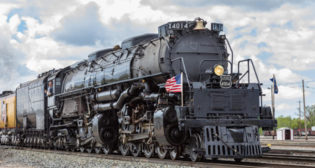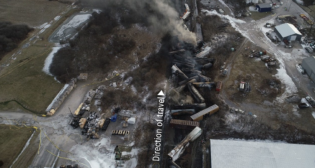
Steady State
Written by David Humphrey, Ph.D, Senior Data Scientist, Railinc Corp.
William C. Vantuono photo
RAILWAY AGE, MAY 2020 ISSUE: Railinc’s analysis of the North American diesel-electric locomotive fleet reveals that the size of the total fleet decreased slightly in 2019. The decrease reflects an excess supply of locomotives due to industry utilization improvements. Detailed analysis reveals the following trends:
- At the end of 2019, the locomotive fleet totaled 39,125, down 393 units from 2018 (see Figure 1).
- The average age increased 0.7 years, to 27.3 years, and the median age increased 0.2 years, to 23.0 years. This was the 10th consecutive year the average and median ages increased.
- Most new additions to the fleet since the mid-1990s have been six-axle locomotives with a horsepower rating of 4,000 or higher. Locomotives with alternating current traction motors (AC units), which perform well at hauling heavy loads, account for the majority of new additions to the fleet in the past decade. And locomotives with the highest fuel capacity—more than 4,500 gallons—make up the largest percentage of the fleet.

Since Railinc began reporting on locomotives, the size of the locomotive fleet has increased each year. This ended in 2018, when the locomotive fleet decreased by three units. In 2019, the locomotive fleet continued its decline, decreasing by 393 units to 39,125 units, for a growth rate of –1.0%, down from the previous year’s growth rate of 0% (see Figure 1).
NEW ADDITIONS TO FLEET REMAIN LOW
About 244 new locomotives joined the North American fleet in 2019, up from 164 the previous year (see Figure 2). It was the third consecutive year that the fleet added fewer than 300 new units.

Historically, the average age of the fleet and the number of locomotives added to the fleet mirror the economic environment. When the economy is strong—as in the mid-1990s and mid-2000s—and there are more railcars in service, the average age is lower and the fleet tends to grow. During periods of recession, fewer new locomotives join the fleet. However, the decrease in 2019 reflects an excess supply of locomotives due to industry utilization improvements.
As new locomotives join the fleet each year, larger railroads move older units to less-demanding roles, sell them to regional and short line railroads or make them available to be rebuilt or refurbished.
A locomotive has a long service life and can be used in a variety of ways over that time. It can make long hauls during its first decades of service. Then, it can work on regional and short line railroads in middle age. Finally, it can perform lighter duty service—such as moving railcars in a yard—at 60 or 70 years old.
AC UNITS CONTINUE GROWTH
DC traction locomotives make up 64% of the North American fleet, down one percentage point from the previous year. The share of AC traction locomotives has increased 10 percentage points since 2009 as more AC units join the fleet
(see Figure 3).

Although DC diesel locomotives continue to make up close to two-thirds of the North American fleet, AC locomotives have dominated among additions in the past 12 years. Only 39 DC units were added in the past two years, and in the past six years, about 94% of all new locomotives were AC units.
Locomotives with a horsepower rating of 4,000 or higher continue to make up the majority of the North American locomotive fleet. These locomotives comprised 56% of the fleet in 2019 (see Figure 4).

As a percentage of the fleet, locomotives between 2,000 and 3,999 horsepower comprised 32% in 2019, down from 38% in 2009.
The fleet does continue to add lower-horsepower locomotives, though at generally decreasing rates. These lower-horsepower additions to the fleet are made up of rebuilt locomotives and new units used as switcher locomotives.
Locomotives with a horsepower rating of 4,000 or higher dominate among AC locomotives, which tend to be newer. Overall, there are about twice as many DC locomotives in the North American fleet than AC units. However, DC units are more evenly distributed by horsepower rating—and locomotives with horsepower ratings of less than 4,000 make up the largest share.
Six-axle locomotives make up 69% of the North American locomotive fleet, the ninth consecutive year of no change.
Six-axle locomotives distribute the weight of a locomotive to the rails across more wheels and deliver tractive effort through more wheels and traction motors. The majority of six-axle locomotives were built in the past 30 years.
Locomotives with fuel capacity of more than 4,500 gallons make up 55% of the North American fleet. This share has grown in recent years, while the share of locomotives with fuel capacity between 3,500 and 4,500 gallons continues to decrease (down six percentage points since 2009). This is consistent with the recent trend of the fleet adding new high-horsepower, six-axle locomotives, which have larger fuel tanks.
ROAD UNITS AND SWITCHERS
To distinguish locomotives used in road service from those used in switching service, Railinc has applied the following definitions:
- A road unit is a locomotive with six axles and a horsepower rating of 2,500 or higher.
- A switcher is a locomotive with four axles and up to 2,500 horsepower.
Road units make up 67% of the North American locomotive fleet, while switchers account for about 22% of the population. Locomotives with four axles and a horsepower rating higher than 2,500 make up 9% of the fleet. However, the rail industry shifted away from making this locomotive type in the mid-1990s, and most additions of this type are refurbished units.
Railinc is a wholly owned subsidiary of the Association of American Railroads. For more information, visit www.railinc.com.



